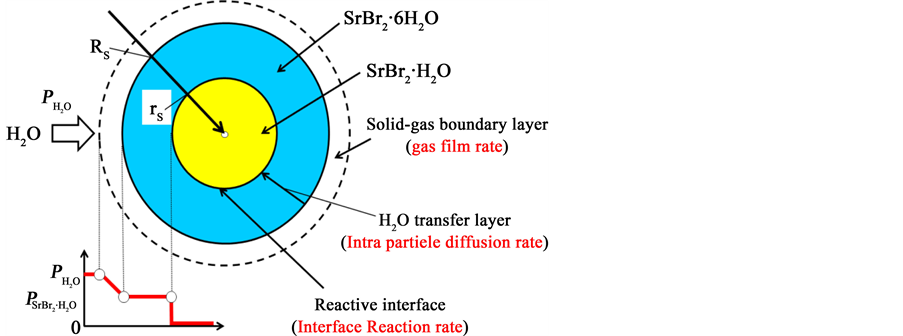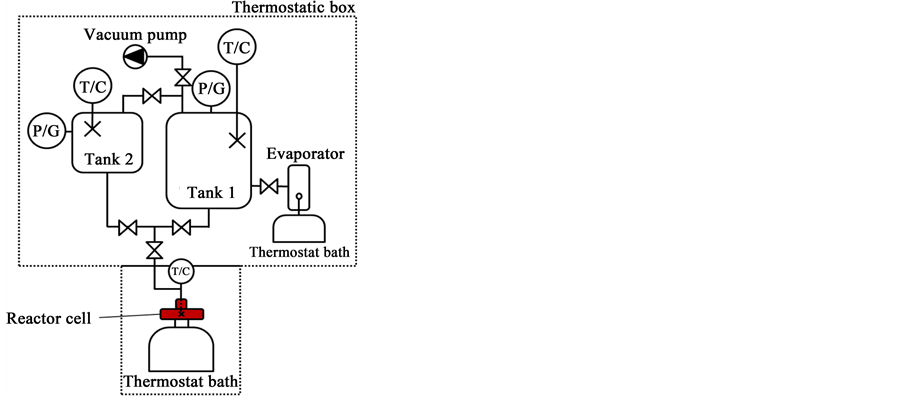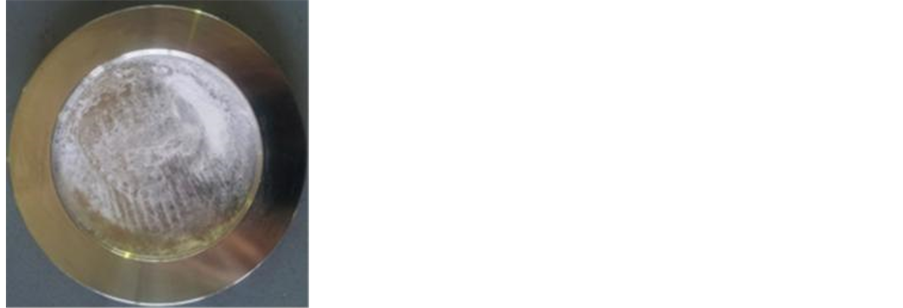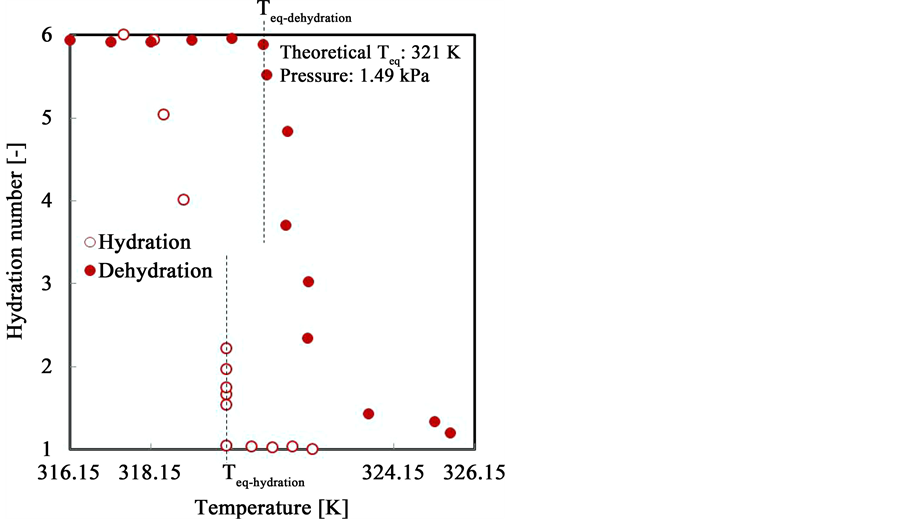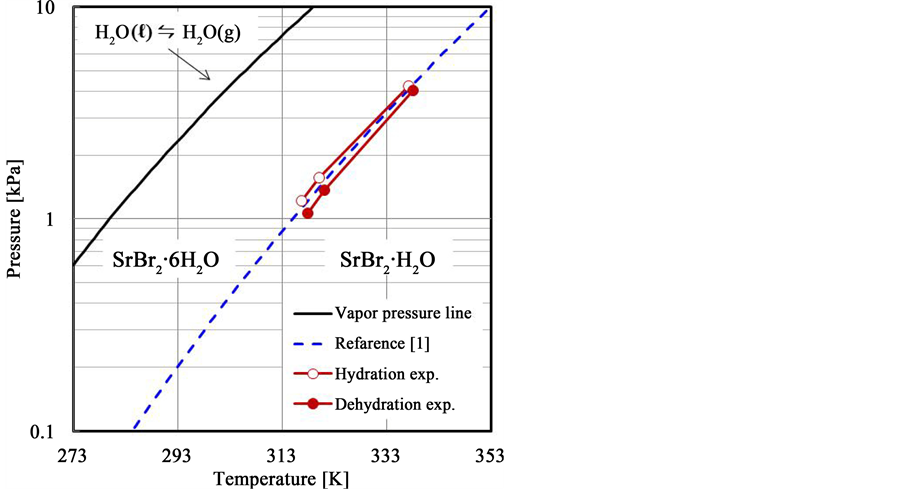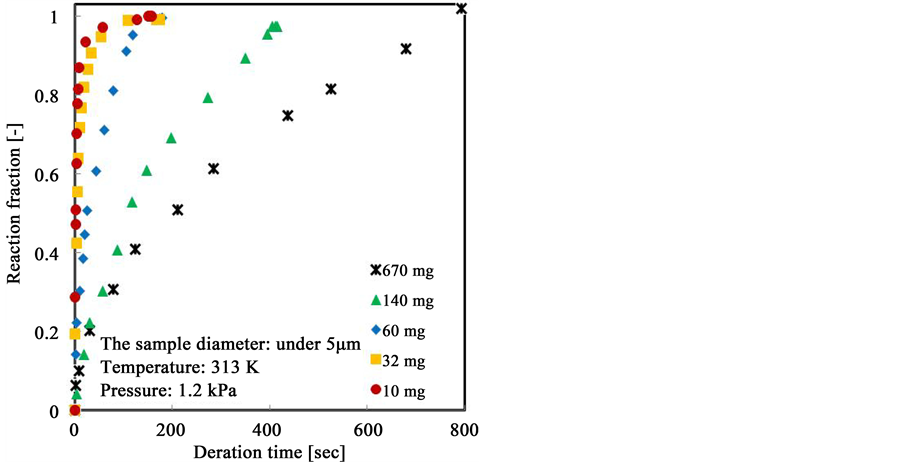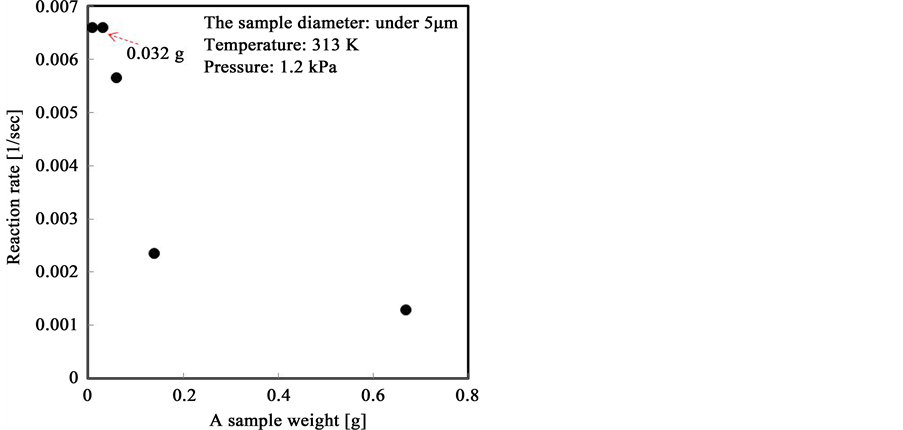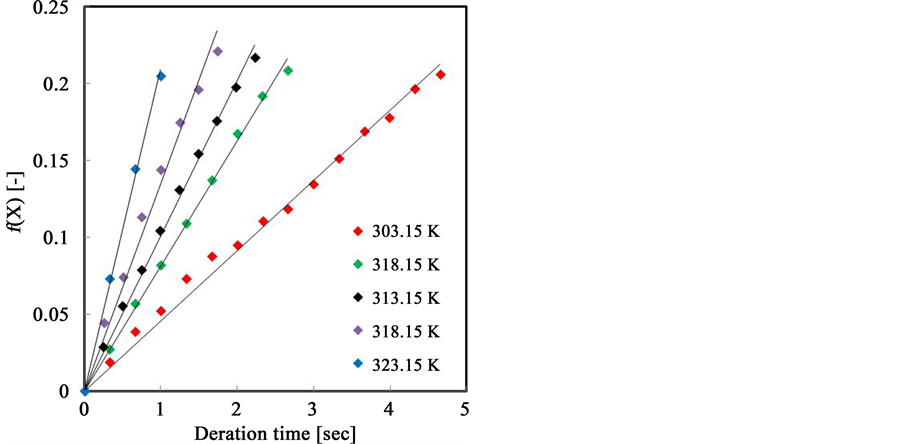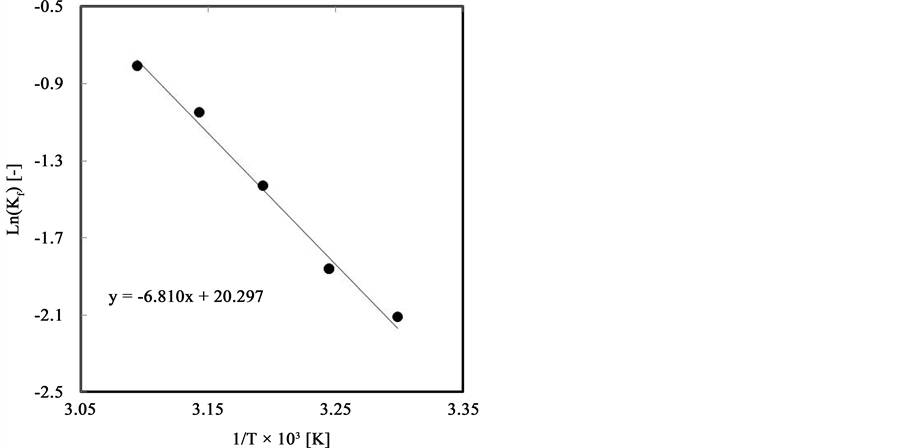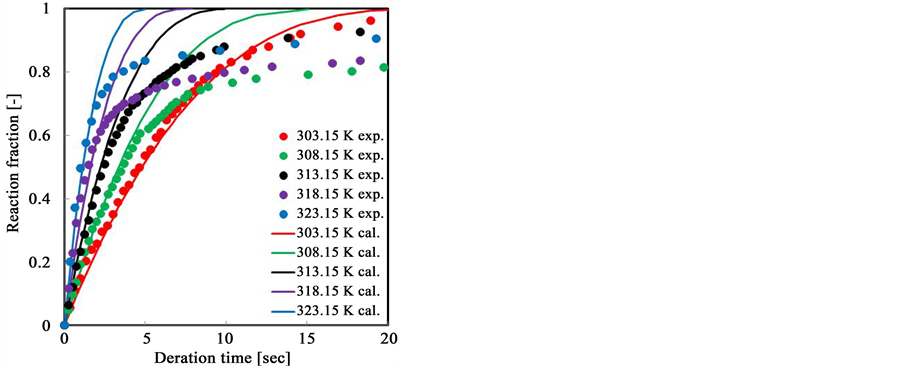Journal of Materials Science and Chemical Engineering
Vol.04 No.02(2016), Article ID:63997,10 pages
10.4236/msce.2016.42012
Reaction Rate Characteristics of SrBr2 Hydration System for Chemical Heat Pump Cooling Mode
Takehiro Esaki*, Noriyuki Kobayashi
Department of Chemical Engineering, Nagoya University, Nagoya, Japan

Copyright © 2016 by authors and Scientific Research Publishing Inc.
This work is licensed under the Creative Commons Attribution International License (CC BY).
http://creativecommons.org/licenses/by/4.0/



Received 20 November 2015; accepted 25 February 2016; published 29 February 2016
ABSTRACT
Here, we propose a chemical heat pump chiller with a SrBr2 hydration reaction system for utilization of waste heat. The SrBr2 hydration reaction could recover waste heat in low temperatures ranging from 373 K to 353 K, and the system showed good potential in terms of the high cooling thermal-storage density. Previous studies have given little information on the reaction characteristics of the SrBr2 hydration reaction. In this paper, we developed a measuring method for the hydration reaction equilibrium and reaction rate based on the volumetric method. We analyzed the hydration reaction rate with an unreacted-core shell model. In the experiments, the SrBr2 equilibrium temperature observed was equal to the theoretical equilibrium temperature obtained from thermodynamic databases. In addition, the hysteresis gap between the hydration and dehydration values was 2.0 K. Thus, the hysteresis effect was negligible for the chemical heat pump cooling operation. The reaction fraction of the SrBr2 hydration reached 0.7 within 20 s. By analyzing the hydration reaction rate with the unreacted-core shell model, the activation energy value was calculated to be56.6 kJ/mol. The calculation results showed good agreement with those of the experiment as the reaction fraction reached 0.7.
Keywords:
Chemical Heat Pump, SrBr2 Hydration, Hysteresis, Unreacted-Core Shell Model

1. Introduction
In correspondence with increasing energy consumption since the Industrial Revolution, the amount of industrial waste heat has been rising. Energy-cascading technologies have been developed to save on energy consumption, and recently, chemical heat pumps (CHPs) have been receiving much attention. The CHPs can store waste heat and supply energy at various temperature levels on demand [1] [2] . In particular, CHP cooling modes can store waste heat at levels fewer than 423 K and can supply cooling heat at levels around 283 K. In previous reports, reaction systems for CHP cooling modes have employed the hydration reactions of calcium chloride (CaCl2 + 6H2O ⇋ CaCl2∙6H2O) and calcium sulfate (CaSO4 + 1/2H2O ⇋ CaCl2∙1/2H2O) [3] [4] . In the present study, we selected the hydration reaction of SrBr2 for the CHP reaction system. Chemical heat pumps employing the SrBr2 hydration reaction can be used to recover waste heat over low temperature range (373 - 353 K) and have good potential in terms of their high cooling thermal-storage density [5] . The relevant reaction formula is as follows:
 (1)
(1)
A previous study by Lahmidi et al. (2006) has revealed that CHPs employing the SrBr2 hydration reaction can be used to provide heating and cooling storage functions with solar thermal systems [6] . Although CHPs with SrBr2 hydration systems can save on energy consumption, there is little information available on the reaction rate for the SrBr2 hydration reaction. The reaction rate is necessary for designing engineering applications for CHPs, but it can be quite difficult to measure the hydration reaction rate for CHP reaction systems. We should exclude the effects of thermal and mass transfer resistance in order to measure the hydration reaction rate. The thermal resistance of a SrBr2 packed bed is very high. In addition, in the H2O low pressure range, the H2O mass transfer resistance is very high.
We have developed a measuring method for the hydration reaction rate based on the volumetric method. We can analyze the hydration reaction rate with this method on the condition that the effects of thermal and mass transfer resistance are minimized.
During the reactions for CHPs, it is well known that the hydration/dehydration reactions display hysteresis between the theoretical and ideal equilibrium (Matsuda et al., 1985; Kubota et al., 2000; Ogura et al., 2007) [7] -[9] . The hysteresis of the hydration reaction can affect the cooling output for on-demand needs at various temperature levels.
In this work, we have examined the SrBr2 hydration reaction characteristics for CHP cooling modes. We discuss both 1) the equilibrium vapor temperature of the SrBr2 hydration reaction―during which we identify ideal equilibrium relations of the SrBr2 hydration reaction―and 2) the reaction rate of hydration―whereby we evaluate the reaction rate correlations with anunreacted-core model.
2. Experimental
2.1. Reaction Model
Solid-gas reaction models have been suggested for use as mathematical models. From such models, we selected an unreacted-core model. This model was utilized in the analysis of the hydration/dehydration reaction system [8] . Figure 1 shows a schematic diagram of the unreacted-core model for the solid−gas hydration reaction. In the hydration reaction, H2O moisture is transferred to a uniform particle SrBr2∙H2O. The SrBr2∙H2O and H2O moisture react on the particle interface. Further, H2O moisture is transferred to the inside particle and the reaction is assumed to proceed from the outside toward the center.
So, the overall hydration reaction rate is composed of three steps. These steps include the interface reaction rate-determining step,the intra particle diffusion rate-determining step, and the gas film rate-determining step. Overall, the reaction rate can be written as follows:
 (2)
(2)
where krf, De, and kr are expressions for the gas film coefficient, intra particle diffusion coefficient, and rate coefficient of the reaction, respectively. Rs is the particle radius. Pe and P represent the SrBr2 hydration equilibrium pressure and the system pressure, respectively. In general, the gas film rate is much faster than the interface reaction rate and intra particle diffusion rate under measuring rate conditions. It may be assumed that the gas film rate is not affected by the overall reaction rate. Here, the overall reaction rate r was rewritten by shortening the gas film rate step. The overall reaction rate γ is as follows:
Figure 1. Schematic diagram of the unreacted-core shell model for the solid-gas hydration reaction.
 (3)
(3)
Equation (2) was expanded in order to determine the steps that affect the overall reaction rate. If each step influences the overall reaction rate, Equations ((5) and (7)) can be obtained on the supposition of the effect step.
2.1.1. Intra Particle Diffusion Rate-Determining Step
In this case, the reaction rate is defined as follows ( ):
):
 (4)
(4)
The following Equation (5) was obtained by integrating Equation (4):
 (5)
(5)
2.1.2. Interface Reaction Rate-Determining Step
In this case, the reaction rate is defined as follows ( ):
):
 (6)
(6)
The following Equation (7) was obtained by integrating Equation (6):
 (7)
(7)
and
 (8)
(8)
 (9)
(9)
By use of Equations ((4) and (6)), the f(X) plot with time can be obtained for the reaction rate-determining step.
2.2. Experimental Apparatus
The experimental apparatus used for the volumetric measurements is shown in Figure 2. This apparatus consisted of H2O moisture tanks 1 and 2, a reactor cell, which was made of stainless steel, valves, pressure gages, a thermo-controlled heater, thermo couples, a Pt resistance temperature sensor, a vacuum pump, and a PC (personal computer). This apparatus was enclosed in a thermostatic box. H2O tanks 1 and 2 had volumes of 176,000 cm3 and 13,000 cm3, respectively. We adjusted the tanks for some experimental conditions. The tanks were equipped with set pressure gages (ULVAC, CCMT-100D) with a maximum uncertainty of 3.0 Pa, and we could measure the minute pressure changes associated with the hydration/dehydration reactions by PC. The reaction cell was connected to the heating/cooling system by the thermostat bath. The sample in the reaction cell was measured with the Pt resistance temperature sensor.
A sample of SrBr2∙6H2O was obtained from KANTO CHEMICAL Co., Inc., in Japan. We heated the SrBr2∙ 6H2O at 353 K to obtain non-hydrated SrBr2 for the initial experiments. Thereafter, the sample particle diameter was adjusted for the experimental conditions.
2.3. Experimental Procedure
A sample in the reaction cell is shown in Figure 3. Once a sample was set, we sealed the reaction cell. The experimental equipment was first degased under 50 Pa. In order to set the desired pressure, H2O vapor was introduced to the tanks. Operations involved opening the valves and connecting the reaction cell and the tank. During hydration, the tank pressure dropped. During dehydration, the tank pressure rose. The tank pressure value was
Figure 2. Schematic diagram of the experimental apparatus for the volumetric method.
Figure 3. SrBr2 sample in the reaction cell.
recorded on a PC. When the tank pressure change reached an equilibrium state, we calculated the amount of H2O used in the hydration/dehydration reaction from the quantity of the pressure change. In this method, the tanks and the sample weight of SrBr2 were adjusted in order to keep the quantity of tank pressure change under 5%.
A previous study revealed that a decline in the reaction rate will occur during hydration reaction repetition (Kato et al., 1998). The hydration/dehydration reaction involves the expansion and contraction of reactant particles and particle condensation. We confirmed that the effect of SrBr2 hydration reaction repetition was negligible on the reaction rate over 10 repetitions.
3. Results and Discussion
3.1. Hydration Reaction Equilibrium
The thermodynamic equilibrium of the SrBr2 1 - 6 hydration reaction was expressed by the Clausiu-Clapeyron equation as follows:
 (10)
(10)
where Pe and Te are the equilibrium pressure and temperature, respectively. P0 is the atmospheric pressure. ∆H and ∆S represent the enthalpy and entropy changes in the reaction, respectively.
In this experiment, 50 mg of non-hydrated SrBr2 (particle diameter 100 - 106 μm) was placed in the reaction cell. Then, the tank was pressurized to the experimental pressure and the sample was allowed to react to 0 - 1 hydration at equilibrium temperature. During the hydration step, the thermostat bath temperature for the reaction cell was lowered at a rate of 1 (K/h). The temperature of the reaction cell then achieved the SrBr2 1 - 6 equilibrium temperatures, and the tank pressure dropped along with the hydration reaction. When the pressure dropped quickly, it was recorded as the hydration equilibrium temperature at the set pressure. When SrBr2 was hydrated at the equilibrium temperature, the temperature of the reaction cell was kept stable until the sample was completely hydrated.
After the hydration reaction was complete, the temperature of the reaction cell was raised and we measured the dehydration equilibrium temperature. During this experiment, the quantity of the pressure change with the hydration reaction was sufficiently small relative to the set pressure, which means that the reaction occurred under isobaric conditions.
An experimental demonstration is shown in Figure 4. The equilibrium temperature of the hydration reaction was determined as the temperature where the pressure change appeared. Hysteresis appeared between the hydration and dehydration reactions. We measured the hydration/dehydration equilibrium temperature under some different pressure conditions. The experimental results are summarized in Table 1 and Figure 5. Table 1 shows the temperature difference data between the experiment and the reference data. The reference data represent the theoretical equilibrium line derived from thermodynamic databases. In Figure 5, the hydration/dehydration equilibrium temperature obtained from this experiment was approximately equal to that of the reference data. In addition, the hysteresis gap between the hydration and dehydration values was 2.0 K. Thus, the hysteresis effect was negligible for the CHP cooling mode.
3.2. Effect of Sample Weight on the Reaction Rate
In this experiment, we evaluated the effect of sample weight on the hydration reaction rate. The sample weights used were 10, 32, 60, 140, and 670 mg. As the sample weight increased, the thickness of the sample packed beds increased. Heat and mass transfer resistance depended on the sample packed bed thickness. Figure 6 shows the effect of sample weight on the reaction fraction, where Xreact with time is the reaction fraction of the sample weight in the hydration reaction. The reaction fraction was defined by

Figure 7 shows the reaction rate as values approach Xreact = 1.0. The overall reaction rate increased as the weights decreased from 670 to 32 mg; the reaction rate did not increase any further from 32 to 10 mg. We can thus exclude the effect of thermal and mass transfer resistances and obtain the hydration reaction rate under the 32 mg sample weight.
Figure 4. Experimental demonstration of determining the hydration/ dehydration temperature.
Figure 5. Equilibrium temperature dependence of the SrBr2 hydration reaction.
Table 1. Temperature differences between the experimental and reference data.
Figure 6. Typical time variation of the reaction fraction for different sample weights.
Figure 7. Effect of sample weight on the reaction rate.
3.3. Effect of Sample Diameter on the Reaction Rate
We also evaluated the effect of sample particle diameter on the hydration reaction rate. For this, we prepared samples of SrBr2 whose particle diameters were 5 μm, 42 - 52 μm, 100 - 106 μm, and >200 μm. Figure 8 illustrates the fraction reacted with time as a function of the particle diameter. From the measurement results in Figure 8, it can be seen that the completely reacted time was short as the sample particle diameter was small. We estimated that the particle diameter, which is related to the H2O diffusion distance, affected the intra particle diffusion rate. In order to identify the hydration reaction rate, we had to confirm that the effect of particle diffusion was very small. Thus, we measured f(X) plots for the interface reaction rate and intra particle diffusion rate. Figure 9 shows typical f(X) plots reaching Xreact = 0.7 at the particle diameter of 5 μm. The f(X) plot for the interface reaction rate was fairly linear. In contrast, the f(X) plot for the intra particle diffusion rate was non-linear. From the measurement results in Figure 9, the SrBr2 hydration reaction was found to be mainly influenced by the interface reaction rate-determining step with respect to the sample diameter of 5 μm.
Figure 8. Fraction reacted with time as a function of the particle diameter.
Figure 9. f(X) plots reaching Xreact = 0.7 at the particle diameter of 5 μm.
3.4. Evaluation of Reaction Rate under Some Different Temperature Conditions
Figure 10 shows a typical f(x) plot of the interface reaction rate for hydration under different temperature conditions. (1 − Pe/P) was set to 0.38 - 0.4 at each temperature condition. In Figure 10, the slope of f(x) at each temperature condition was large, and the slopes increased as temperature increased. The rate constant of the reaction Kf could be obtained by the slope of the f(X) plots at each temperature condition. Figure 11 shows an Arrhenius plot of logKf versus 1/T. As shown by the measurement results in Figure 11, the plot was linear. In addition, an expression for the reaction rate constant was obtained as

The activation energy was calculated to be 56.6 kJ/mol. This value was lower than that obtained for some different hydration reactions (Kato et al., 1998; Abliz et al., 2002). Thus, SrBr2 hydration reactions could be valuable in many applications.
Figure 12 shows the experimental results and the numerical calculation results derived from the unreacted- core shell model for some different temperature conditions. The calculation results from the unreacted model were fairly linear and comparable to the experimental results up to a reaction fraction of about 60%. However, the reaction rates were different for the experimental results and calculation results at higher levels of the reaction fraction. The SrBr2 hydration reaction rate mainly proceeded under the influence of the interface reaction. The rate-determining process switched from the interface reaction to intra particle diffusion in the middle of the hydration reaction.
4. Conclusions
In this study, SrBr2 hydration reaction characteristics for chemical heat pump cooling modes were evaluated.
Figure 10. A typical f(X) plot of the interface reaction rate hydration at some different temperature conditions.
Figure 11. Arrhenius plot of logKf versus 1/T.
Figure 12. Experimental and calculation results for the fraction reacted with time at different temperature conditions.
From the experimental study and analytic calculations, we obtained the following results.
1) An equilibrium temperature gap existed between the experimental and theoretical data, but the maximum value of the temperature gap was only 2.0 K. Hysteresis was also detected between the hydration and dehydration values in the experiment. Overall, the SrBr2 hydration reaction equilibrium temperature showed good agreement with the theoretical equilibrium temperature.
2) The SrBr2 hydration reaction rate can be measured effectively with the proposed method on the condition that effects of thermal and mass transfer resistance are minimized. In the experiment, the duration time to reach Xreact = 0.7 was within 20 s. By analyzing the hydration reaction rate with the unreacted-core shell model, the active energy value was calculated to be 56.6 kJ/mol. Additionally, the calculation results showed good agreement with the experimental ones at the initial reaction fraction.
Cite this paper
TakehiroEsaki,NoriyukiKobayashi, (2016) Reaction Rate Characteristics of SrBr2 Hydration System for Chemical Heat Pump Cooling Mode. Journal of Materials Science and Chemical Engineering,04,106-115. doi: 10.4236/msce.2016.42012
References
- 1. Kato, Y., Kobayashi, K. and Yoshizawa, Y. (1998) Durability to Repetitive Reaction of Magnesium Oxide/Water Reaction System for a Heat Pump. Applied Thermal Engineering, 18, 85-92.
http://dx.doi.org/10.1016/S1359-4311(97)00058-6 - 2. Abliz, S., Ogura, H., Kage, H. and Matsuno, Y. (2002) Kinetic Study of CaO/Ca(OH)2 reversible Chemical Reaction in Vacuumed Forced Convection for Thermal Energy Storage. Kagaku Kogaku Ronbunshu (Japan), 28, 345-349.
http://dx.doi.org/10.1252/kakoronbunshu.28.345 - 3. Abedin, A.H. and Rosen, M.A. (2012) Closed and Open Thermochemical Energy Storage: Energy- and Exergy-Based Comparisons. Energy, 41, 83-92.
http://dx.doi.org/10.1016/j.energy.2011.06.034 - 4. Ogura, H., Kubota, M., Suzuki, H. and Yazawa, T. (2009) Fundamental Experimental Study on Chemical Heat Pump for storing Low-Temperature Waste Heat and Releasing Cold-Heat. Kagaku Kogaku Ronbunshu (Japan), 35, 506-510.
http://dx.doi.org/10.1252/kakoronbunshu.35.506 - 5. Mauran, S., Lahmidi, V. and Goetz, V. (2008) Solar Heating and Cooling by a Thermochemical Process. First Experiments of a Prototype Storing 60kW h by a Solid/Gas Reaction. Solar Energy, 82, 623-636.
http://dx.doi.org/10.1016/j.solener.2008.01.002 - 6. Lahmidi, H., Mauran, S. and Goetz, V. (2006) Definition, Test and Simulation of Thermochemical Storage Process Adapted to Solar Thermal Systems. Solar Energy, 80, 883-893.
http://dx.doi.org/10.1016/j.solener.2005.01.014 - 7. Matsuda, H., Ishizu, T., Lee, S.K. and Hasatani, M. (1985) Kinetic Study of Ca(OH)2/CaO Reversible Thermochemical Reaction for Thermal Energy Storage by Means of Chemical Reaction. Kagaku Kogaku Ronbunshu (Japan), 11, 542-548.
http://dx.doi.org/10.1252/kakoronbunshu.11.542 - 8. Kubota, M., Kyaw, K., Watanabe, F., Matsuda, H. and Hasatani, M. (2000) Study of Decarbonation of CaCO3 for High Temperature Thermal Energy Storage. Journal of Chemical Engineering Japan, 33, 797-800.
http://dx.doi.org/10.1252/jcej.33.797 - 9. Ogura, H., Haguro, M., Shibata, Y. and Otsubo, Y. (2007) Reaction Characteristics of CaSO4/CaSO4•1/2H2O Reversible Reaction for Chemical Heat Pump. Journal of Chemical Engineering Japan, 40, 1252-1256.
http://dx.doi.org/10.1252/jcej.07WE223
NOTES
*Corresponding author.


